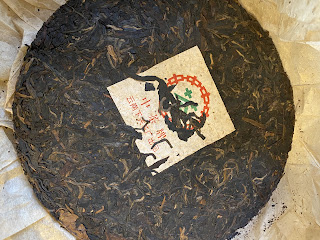I got this sample of 2003 ChenYuan Hao Tong Qing Hao Commemorative cake from Paolo at puerh.uk with my last
order. I implied that I would like to
compare the storage of his Taiwanese source of Chenyuan Hao to (which is
described as clean natural Taiwanese home storage) to that of Teas We Likes
Chenyuan Hao Taiwanese Source (which is a drier/lighter natural Taiwanese
storage). For the sake of comparison and
review Paolo provided the sample free with my first order of this other famous
ChenYuan Hao cake the 2005 ChenYuan Hao Shanzhong Chuanqi, that was previously sold in full cake at
Teas We Like and just now was released as a quarter cake. I sampled from my Teas We Like cake the day
before to get a good read on the comparison… this is going to be super fun…
Dry leaves smell of dry stored sweet leaves almost bubble
gum…
First infusion has a watery fruity clear taste it is mainly
sweet water with a bit of fruity nuance to it in this first infusion. There are some super faint watery notes in
there as well. Some bread notes.
Second infusion has a watery woody sweet candy-like pure
creamy almost tropical sweetness it has a slight bready finish with some bready
sweet notes in there. There is a nice
long sweet bread aftertaste. The taste
is much drier stored and clear simple tastes with not as much richness as the
Teas We Like sample. There is a deeper
relaxing feel to the body and mind.
The third infusion has a sour sweet cherry onset with a pure
clear dry stored presentation. The
subtle sour and sweet cherries pop and subside with a nice faint cooling breath
and vibrant fruity sweet taste. Minutes
later there is this sweet bread taste.
The mouthfeel is a thin fine almost sandy taste with some nice saliva
producing which pushes sweet waves of cherry and almost tropical fruits out in waves
even minutes later… this is a tasty puerh!
Gentle mind relaxing effect with soft shoulder heaviness and neck and
spine release. A little head stuffiness.
The fourth infusion has a sour and sweet presentation that
tastes like sour cherries and has a clear pure vibrancy to it. Nice moderately oily texture. There is some faint bitter astringency in
there after the initial sweet wave. Then
some throat cooling, then some saliva producing with bready sweetness and
subtle sweet and sour tasting fruity taste.
Nice head stuffiness and subtle Qi in the shoulders and neck.
The fifth infusion has a more rich presentation of honey and
sour but mainly sweet creamy tastes.
There is some cooling then a nice strong wave of creamy bread sweet
tastes. Stronger cooling taste as well
as strong sweet returning flavours. Thin
mouthcoating made up by the decently oily texture and saliva producing.
The 6th infusion has a smooth honey woody cherry
fruity not much sour anymore. Woodier
sweet now- classic Yiwu. A creamy
sweetness emerges from the thin full mouthfeeling specifically from the saliva
returning in the back of the throat.
Almost but not really smoke incense appearing… maybe more resin
woody? Nice relaxing with between
shoulder blade very subtle releases.
The 7th is left to cool and has a rich sweet
raison honey woody sweet taste. Really
taste with a thin full coating and some saliva producing effect. Nice relaxing focus. Sweet aftertaste.
8th has a creamy woody taste that pops into a
cherry sweetness with subtle cooling and saliva producing sweetness. Some sweet cherry and slight woody
aftertaste. Nice relaxing Qi here.
9th is left to cool down and gives off a honey
sweet taste with a touch of faint creamy sweetness and woodiness
underneath. The mouthfeeling is a bit
more gripping with less saliva returning.
Relaxing Qi.
I steep this a few more times at flash steepings and it
gives off a sweet taste with creamy sweetness and some fruity sweetness.
I mug steep out the rest and there are some deeper tastes
that come out in these long mug steepings.
A bit of bitter astringency coco too.
It suggests to me that there is still much left in these leaves and that
they just need a bit of pushing to get some more depth out of them.
Vs Teas We Like lighter natural Taiwanese storage- puerh.uk storage was much drier and was likely dry stored for most of its life. The dry storage of this puerh.uk sourced cake gives the puerh much more clarity but also less depth of taste. The clarity of the dry storage allows for much simpler appreciation of the sweet tastes which shine in this production however they also bring out some sour tastes. Some might see this sour as a negative but right now I’m drinking a Gose beer and I’m thinking it isn’t so bad.. My 2005 Chenyuan Hao Shanzhong ChuanQi doesn’t have this sour although the storage is the same source, I believe. The Qi of both storage is about the same. The Teas We Like might be a bit thicker in the mouth.
I think I enjoyed the Teas We Like storage a little bit more due to its depth of taste and density of flavour however the price difference between the two types reflects this with the Teas We like cake going for $600.00 for 357 g cake vs puerh.uk cake going for approx. $515.00. There are going to be some dry storage lovers that will definitely prefer the drier puerh.uk storage better or find it better value for the cheaper price. I also would guess that I would also slightly prefer the Teas We Like natural slightly more humid Taiwanese on the powerful 2005 Chenyuan Hao Shanzhong ChuanQi as well. I just ordered some Quarter cakes so we are going to find out… fun comparison! I recommend anyone who is interested to do these comparison for themselves as Teas We Like just dropped a bunch of Quarter cakes.
Peace






















